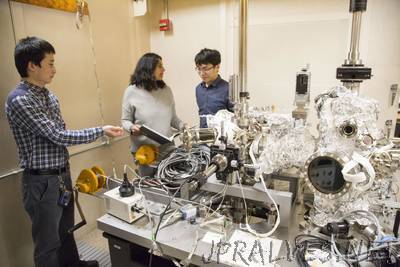
“Since the discovery two decades ago of the unconventional topological superconductor Sr2RuO4, scientists have extensively investigated its properties at temperatures below its 1°K critical temperature (Tc), at which a phase transition from a metal to superconducting state occurs. Now experiments done at the University of Illinois at Urbana-Champaign in the Madhavan and Abbamonte laboratories, in collaboration with researchers at six institutions in the U.S., Canada, United Kingdom, and Japan, have shed new light on the electronic properties of this material at temperatures 4°K above Tc. The team’s findings may elucidate yet-unresolved questions about Sr2RuO4’s emergent properties in the superconducting state. Vidya Madhavan, a physics professor and member of the Frederick Seitz Materials Research Lab at the U. of I., led the experiment. She explains, “We began from the widely held assumption that, in Sr2RO4’s normal metallic state above its Tc, the interactions of electrons would be sufficiently weak, so that the spectrum of excitations or electronic states would be well defined.” Madhavan continues, “However, and this is a big surprise, our team observed large interaction effects in the normal metallic state. Electrons in metals have well defined momentum and energy. In simple metals, at low temperatures the electrons occupy all momentum states in a region bounded by a ‘Fermi surface.’ Here we found that the velocity of electrons in some directions across the Fermi surface were reduced by about 50 percent, which is not expected. We saw similar interaction effects in the tunneling density of the states. This is a significant reduction, and it was a great surprise. We thought we would just find the shape of the Fermi surface, but instead, we get these anomalies.” Eduardo Fradkin, a physics professor and the director of the Institute for Condensed Matter Theory at the U. of I., comments, “The basic electronic properties of this material have been known for some time. Scientists study this material because it’s supposed to be a simple system for testing scientific effects. But the material has also been a source of ongoing debate in the field: this is a p-wave superconductor, with spin-triplet pairing. This has suggested that the superconducting state may be topological in nature. Understanding how this system becomes superconducting is an open and intriguing question.””
